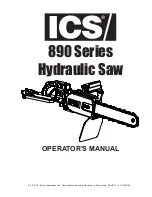
Page 7
To reduce the risk of electric shock, follow all
electrical and safety codes, including the
National Electric Code (NEC) and the
Occupational Safety and Health Regulations
(OSHA). All electrical connections and wiring
should be made by qualified personnel only.
WARNING
!
This machine
MUST BE GROUNDED
while in use to protect the operator from
electric shock.
WARNING
!
In the event of a malfunction or breakdown,
GROUNDING
provides the path of least resistance for electric current and
reduces the risk of electric shock. The plug
MUST
be
plugged into a matching electrical receptacle that is
properly installed and grounded in accordance with
ALL
local codes and ordinances.
If a plug is provided with your machine
DO NOT
modify the
plug. If it will not fit your electrical receptacle, have a
qualified electrician install the proper connections to meet
all electrical codes. All connections must also adhere to all
of OSHA mandates.
IMPROPER ELECTRICAL CONNECTION
of the
equipment-grounding conductor can result in risk of electric
shock. The conductor with the green insulation (with or
without yellow stripes) is the equipment-grounding
conductor.
DO NOT
connect the equipment-grounding conductor to a
live terminal if repair or replacement of the electric cord or
plug is necessary.
Check with a qualified electrician or service personnel if you
do not completely understand the grounding instructions,
or if you are not sure the tool is properly grounded.
MINIMUM RECOMMENDED GAUGE FOR ExTENSION CORDS (AWG)
115/230 VOLT OPERATION ONLY
25’ long
50’ long
100’ long
0 to 6 Amps
18 AWG
16 AWG
16 AWG
6 to 10 Amps
18 AWG
16 AWG
14 AWG
10 to 12 Amps
16 AWG
16 AWG
14 AWG
12 to 15 Amps
14 AWG
12 AWG
Not
recommended
◊ ExTENSION CORDS
◊ PLUGS/RECEPTACLES
MAKE SURE
the circuit breaker does not
exceed the rating of the plug and
receptacle.
WARNING
!
To reduce the risk of fire or electrical
shock, use the proper gauge of extension
cord. When using an extension cord, be
sure to use one heavy enough to carry the
current your machine will draw.
WARNING
!
The smaller the gauge-number, the larger the diameter of
the extension cord is. If in doubt of the proper size of an
extension cord, use a shorter and thicker cord. An
undersized cord will cause a drop in line voltage resulting
in a loss of power and overheating.
WARNING
!
If you are using an extension cord outdoors, be sure it is
marked with the suffix “W-A” (“W” in Canada) to indicate
that it is acceptable for outdoor use.
Make certain the extension cord is properly sized, and in
good electrical condition. Always replace a worn or
damaged extension cord immediately or have it repaired by
a qualified person before using it.
Protect your extension cords from children, sharp objects,
excessive heat, and damp or wet areas.
USE ONLY
a 3-wire extension cord that has
a 3-prong grounding plug and a 3-pole
receptacle that accepts the machine’s
plug.The third prong is used to ground the
tool and provide protection against
accidental electric shock.
DO NOT
remove the third.
◊ MAGNETIC SAFETY SWITCH
If the machine is equipped with a magnetic safety switch
you must to reset the overload protection switch after an
overload.
1. Remove the control box cover.
2. Press the reset button.
3. Reinstall the control box cover.
Make certain that the machine is disconnected
from the power source
WARNING
!
ELECTRICAL AND GROUNDING INSTRUCTIONS
Summary of Contents for 10-722
Page 21: ...Page 21 PART LISTS A...
Page 22: ...Page 22...
Page 23: ...Page 23 B...
Page 24: ...Page 24...
Page 25: ...Page 25...
Page 26: ...Page 26 C...
Page 27: ...Page 27...
Page 28: ...Page 28 D...
Page 29: ...Page 29...
Page 30: ...Page 30...
Page 31: ...Page 31 E...
Page 32: ...Page 32...
Page 33: ...Page 33...
Page 34: ...Page 34...
Page 35: ...Page 35...
Page 36: ...Page 36 u NOTES u...








































